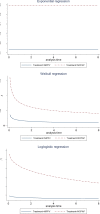Comparison of nasal intermittent positive pressure ventilation and nasal continuous positive airway pressure treatments using parametric survival models
- PMID: 25535541
- PMCID: PMC4268842
Comparison of nasal intermittent positive pressure ventilation and nasal continuous positive airway pressure treatments using parametric survival models
Abstract
Objective: The Cox model is the dominant tool in clinical trials to compare treatment options. This model does not specify any specific form to the hazard function. On the other hand, parametric models allow the researcher to consider an appropriate shape of hazard function for the event of interest. The aim of this article is to compare performance of Cox and parametric models.
Methods: We used data collected in a prospective clinical trial that aimed to compare performance of nasal intermittent positive pressure ventilation (NIPPV) and nasal continuous positive airway pressure (NCPAP) treatments in terms of survival of newborn infants who had respiratory distress syndrome (RDS). Performance of Cox, exponential, Weibull, and log-logistic models were compared in terms of goodness of fit.
Findings: Fitting the Cox model, we have seen that infants who received NCPAP were 4.23 (Hazard Ratio= 4.23, 95% Confidence Interval: 1.87-9.59) times more likely to fail than those received NIPPV (P=0.001). Adequacy of the exponential model was rejected. We have seen a decreasing hazard rate over time, in both treatment groups. This decrease was sharper in NCPAP group. Akiake information criterion corresponded to the log-logistic model and was lower than all other models followed by Weibull model.
Conclusion: Our results demonstrate the benefit of parametric survival models over traditional Cox regression model in terms of modeling of shape of hazard function. We saw a decreasing hazard that confirms the flexibility of parametric models in terms of the modeling of hazard rate.
Keywords: Infant Mortality; Parametric Survival; Respiratory Distress Syndrome; Weibull.
Figures
References
LinkOut - more resources
Full Text Sources



